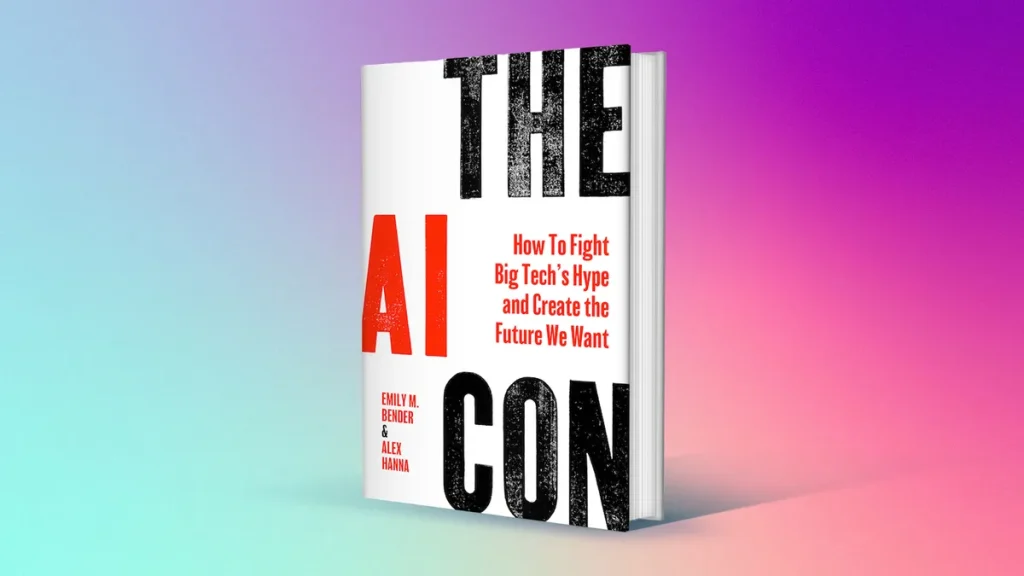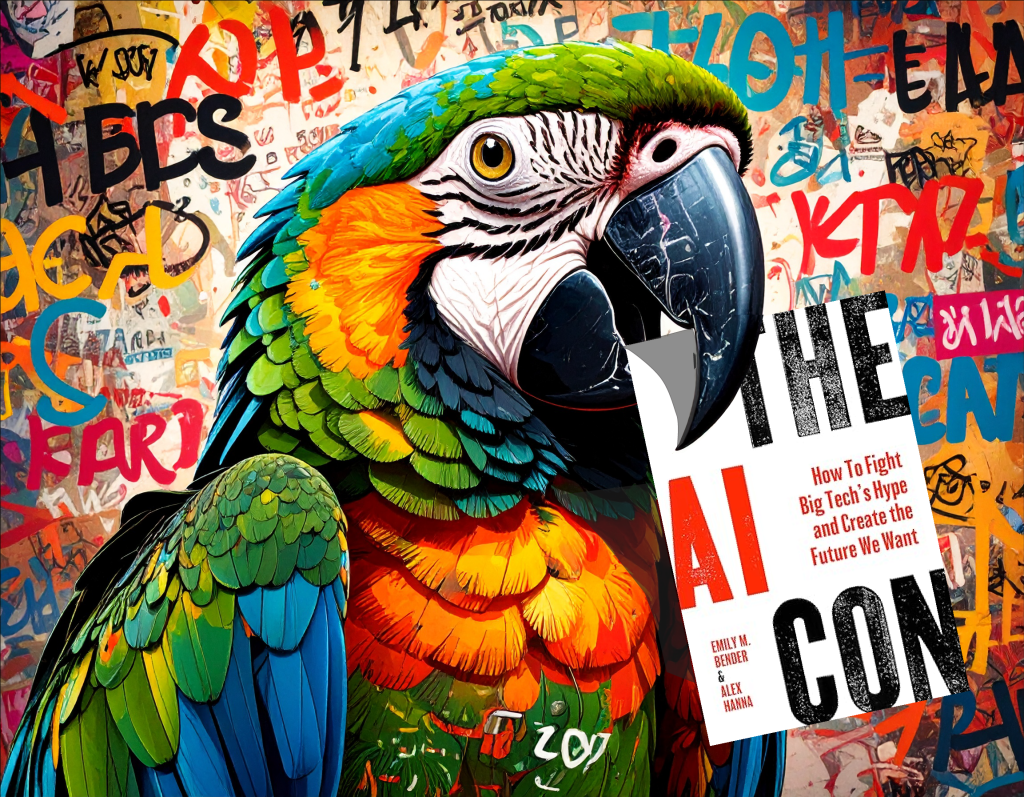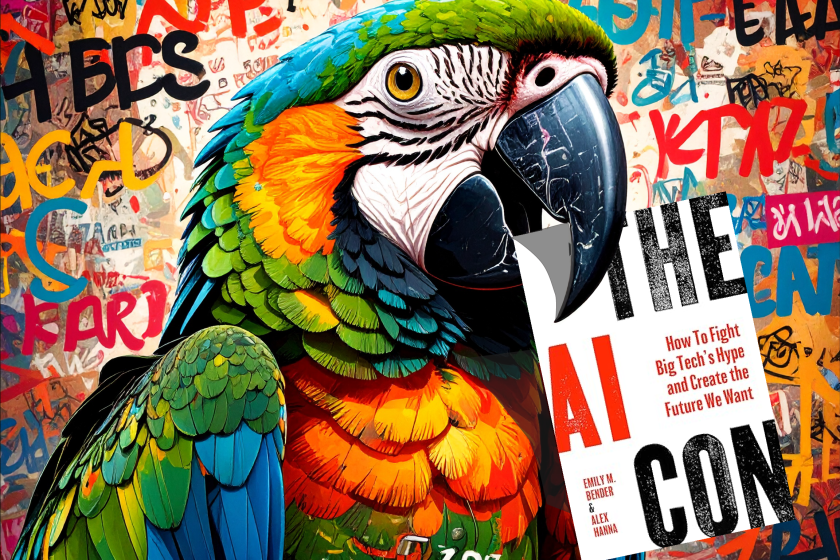Before you panic and spend $1995 on “Becoming a Prompt Engineering Hero” or enroll your preschoolers in that summer school class “AI for Toddlers”: read this book. It will not only save you lots of money, but it will save two of the most important things you have: your time and your sanity.
Emily Bender and Alex Hanna drop an atomic truth bomb onto “AI” – and may I say, the truth bomb is extremely well-written and extremely well-deserved.
Yet the book is not all doom and gloom. Bender and Hanna give you a practical guide to a brighter future in their book. As the subtitle indicates, “How to Fight Big Tech’s Hype and Create the Future We Want”, there is life after cutting through the “Con”.
Cutting Through the Hype
I have been in “AI” and the NLP industry for over 40 years and with each new advancement in “AI”, machines are going to take over the world and it is the end of humankind. The difference this time is the size and scope of the hype.
Because of social media and the fact that billions of humans now have instant access to the internet, everyone has access to generative models that create images and video from text, or programs like ChatGPT that “seems” to be all knowing and sentient. The “AI” hype wagon is so ginormous this time around, that eradicating it from the landscape is not a simple task. “The AI Con” to the rescue!

Those of us who have been around “AI” for decades, are giving our collective praise and sighs-of-relief that two of our brilliant colleagues, Bender and Hanna, have unilaterally decided that the way to end this war on “AI Hype” is to drop a proverbial atomic truth bomb on the entire “AI Cabal”. Like Dwight D. Eisenhower’s decision to drop the atomic bomb to end to WW2, Bender and Hanna have decided to drop truth onto the “AI” hype that is consuming us with lies, deceptions, and most importantly: fear. And fear sells.

Entertaining and Informative
Ok, “AI” books can promise a heavenly future, be unintelligible, or be even downright scary. This book is none of those. In fact, I give it an A+ on humor and content. Bender and Hanna use humor throughout their tome, and I suspect it may have come from the fact that both are trying to keep their sanity intact while writing this book and fighting the “good fight”. Either way, it makes for a fun and interesting read.
They also include interesting examples of “AI” gone wrong like the now famous story of the Lawyer who used ChatGPT to submit a case that didn’t exist, to a professor using ChatGPT to see if students used ChatGPT to cheat on their essays. Talk about the blind leading the blind! 😎 There are more examples to enjoy in the book.
The table of contents gives you a hint of the fun and inform inside:
- Chapter 1: An Introduction to Al Hype
- Chapter 2: It’s Alive! The Hype of Thinking Machines
- Chapter 3: Leisure for Me, Gig Work for Thee: Al Hype at Work
- Chapter 4: If It Quacks Like a Doc: Al Hype and Social Services
- Chapter 5: Artifice or Intelligence? Al Hype in Art, Journalism and Science
- Chapter 6: I’m Sorry, Dave, I’m Afraid I Can’t Do That: AI Doomers, AI Boomers, and Why None of That Makes Sense
- Chapter 7: Do You Believe in Hope After Hype?
I especially like how Bender and Hanna broke the book down into subjects that everyone can relate to. That’s really knowing your audience.
About the Authors
Dr. Emily Bender is a computational linguist, adjunct professor at Washington University, and was recently the president of the Association for Computational Linguistics (ACL), the oldest organization in computational linguistics in the world. Dr. Bender also testified before the U.S. House Committee on Science, Space, and Technology on October 18, 2023, addressing the risks associated with AI technologies.
I first met Emily when she recently gave the keynote speech as president of the ACL in Bangkok Thailand in 2024. After her keynote speech, a student got up with a comment and question saying something like “… we are trying to understand how generative ‘AI’ reasons… blah blah blah”. Not knowing Bender at the time, I thought: here it comes, she will ignore or even support the hype. Nope. Bender said that before she could answer the question, she had to explain to the student that generative “AI” does not reason. That is when I knew that she was a force to be reckoned with.
Dr. Alex Hanna is a sociologist and Director of Research at the Distributed AI Research Institute (DAIR). Before joining DAIR, Hanna was part of Google’s Ethical AI team, where she worked on issues related to bias in “AI” systems and data ethics. Her research focuses on how computational technologies reinforce racial, gender, and class inequalities. She also co-hosts the podcast Mystery AI Hype Theater 3000, where she and Bender discuss misconceptions and exaggerated claims about “AI” in a humorous, fun, yet serious discussions. I highly recommend the podcast!
Teaching the Masses About the Technologies
I know from personal experience, that when you teach someone how generative actually “AI” works, that people immediately become less impressed. This is not easy to do. Bender and Hanna do this masterfully. They mince no words when telling the truth about large language models:
But to be clear: neither large language models nor anything else being sold as “AI” is conscious, sentient, or able to function as an independent, thinking entity. Despite the proclamations of corporate and academic boosters like Agüera y Arcas and Minsky, technologies that synthesize text or solve mathematical puzzles are not artificial life-forms. However, it serves many people to say so: entrepreneurs who have a product to sell, researchers who have academic departments to fund, and zealots who have institutions or followers that would benefit from such a fiction being perpetuated.
Bender, Emily M.; Hanna, Alex. The AI Con: How to Fight Big Tech’s Hype and Create the Future We Want (p. 22). HarperCollins. Kindle Edition.
Ouch! Not really. “YES” is my response!
Sure, it is easy to say, but the authors back up their claims with facts in chapter 2: “The Hype of Thinking Machines”. With sections like “How Large Language Models Actually Work”, to my favorite: “Why We Think ChatGPT Is People”. Sorry, you’ll have to read the book to find out what they say!
It is in the first chapter that the now famous phrase is introduced: “stochastic parrot” to describe large language models. In honor of this, I used firefly from Adobe (which trains on data with the permission of its creators) to generate a “stochastic parrot”. I added a bit of fun on top of it:

Taking Your Jobs… NOT!
When talking about the biggest scare behind “AI” (losing your job), according to the authors, your jobs are safe. They constantly hit you over the head with humor, they are relentless, and have no fear (YES!!). This line made me laugh out loud!
But this promise is highly exaggerated. In the vast majority of cases, AI is not going to replace your job. But it will make your job a lot shittier.
Bender, Emily M.; Hanna, Alex. The AI Con: How to Fight Big Tech’s Hype and Create the Future We Want (p. 42). HarperCollins. Kindle Edition.
I especially like this passage:
AI boosters are falling all over themselves to share their fantasies of how their tools will replace workers. And they have to be: that promise needs to be true for massive valuations of tech companies to be worth it. They are so excited about it, they’ve asked the machine itself whether it would do a better job than human laborers. We’re not kidding.
Bender, Emily M.; Hanna, Alex. The AI Con: How to Fight Big Tech’s Hype and Create the Future We Want (p. 47). HarperCollins. Kindle Edition.
This reminds me of when I confront people who say they like this particular generative “AI” program because it explains what it said. It is a shock to them when I tell them that the explanations from Large Language Models are statistical reactions from training on lots of explanation text and that it has no idea of what it said or why it generates an explanation.
The Social Side of “AI”
The “AI Con” continues into the social aspects of generative “AI”. The “AI Hype Train” creates social injustice given the fact that generative “AI” uses probabilities, not knowledge. Probabilities maps across text have no moral compass – they choose the next segment of text using probabilities, not rules or morals or knowledge.
A 2024 investigation by The Markup, Documented, and the local New York City nonprofit The City revealed that the tool tells its users to flat-out break the law. The chatbot responded that it was perfectly okay for landlords to discriminate…
Bender, Emily M.; Hanna, Alex. The AI Con: How to Fight Big Tech’s Hype and Create the Future We Want (p. 72). HarperCollins. Kindle Edition.
This is an area near and dear to Hanna’s heart and it shows. This chapter wades deep into the social ramifications of “AI”.
Stolen Creativity
The authors don’t mince words when they talk about how “AI” generative systems train on the back of human creativity:
These are probabilistic (aka “stochastic”) algorithms trained on piles of work stolen from creative people.
Bender, Emily M.; Hanna, Alex. The AI Con: How to Fight Big Tech’s Hype and Create the Future We Want (p. 102). HarperCollins. Kindle Edition.
In Dr. Bender’s debate with Sébastien Bubeck Member of Technical Staff of OpenAI on “Do LLMs Really Understand?”, Bender threw in comments that directly implied that OpenAI was training on copyrighted material. In a revealing exchange 51 minutes into the debate (see video below), Bender says about trained, generative systems “the other thing (about this technology) it’s environmentally ruinous, it’s built on stolen data, and it’s built on undisclosed data so we can’t decide when to use it.” Sébastien’s response? “That’s hard to respond to!” Yes it is. She hit him several times about copyright and he avoided it like a hallucination.
The chapter that talks about creativity is full of interesting discussion of creativity in humans and in generative systems and their conflicts in real life with real artists.
Treasure Trove of Examples and Social Implications
Bender and Hanna provide a treasure trove of examples of “AI” gone wrong and its pitfalls. It is one thing to criticize probabilistic technologies as inherently incapable of generating trustworthy data, it’s quite another to talk about real examples of how today’s “AI Hype” is violating copyright law and harming people in order to make “creativity” a simple prompt away. There are social, scientific, and environmental consequences to doing “AI” this way and this book puts it all together in a neat package.
There are a lot of examples of how LLMs are being used for nefarious reasons. Some of the examples given are quite stunning – worth the read just for these alone. One particularly interesting aspect is how “AI” is being promised to find things that humans cannot. We are not talking about machines being able to perform a billion tasks and come up with new protein folds – that is useful. The authors put it simply:
At the core of AI-for-science hype is the idea that AI is somehow going to accelerate science and help us solve pressing scientific problems much faster.
Bender, Emily M.; Hanna, Alex. The AI Con: How to Fight Big Tech’s Hype and Create the Future We Want (p. 117). HarperCollins. Kindle Edition.
The amount of “hypesters” out there pushing “AI” as a “grand accelerator” are part of the problem and the authors talk brilliantly about all of this.
Doomers and Boosters
Bender and Hanna make a fascinating case for how the doomsday promoters and those who see “AI” as a miracle future are actually coming from the same place:
We’d call the former Boosters, while the others we call Doomers. These groups are, counterintuitively, two sides of the same coin: the substance of the coin is the belief that the development of AI is inevitable and that that resulting technology will be both autonomous and powerful, and ultimately beneficial, if we play our cards right.
Bender, Emily M.; Hanna, Alex. The AI Con: How to Fight Big Tech’s Hype and Create the Future We Want (p. 138). HarperCollins. Kindle Edition.
What the authors are addressing IS real. I get questions from ordinary friends who ask me if “AI” are going to take over their jobs and if I have advice for them. The fear is real and Bender and Hanna address this revealing how the doomsdayers and hypesters are both detrimental and wrong.
But is there Hope?
“The AI Con” paints a not-so-pretty picture of the current “AI” landscape and rightly so. Between the “doomers” and the “boosters”, the public is left between a rock and a hard place.
You’d think that the authors were all doom and gloom. But no! Bender and Hanna to the rescue once again!
The authors go through a list of ways to burst the “AI” hype bubble by asking “real” questions and focusing on real problems and real solutions. Part of the solution is to learn more about the technologies to cut through the hype. The authors also suggest how to fight the hype so that we and our organizations don’t waste time and actually solve problems.
Safe to say that the authors present a great roadmap for how to navigate today’s technological waters with concrete suggestions and actions.
Conclusion
For those of you who know me, it is not a surprise that I agree with everything in this book. I am so glad that some of my highly respected peers took the time to write this all down in a neat and entertaining title. Many of us, like the authors, fight “The AI Con” on a daily basis. But it is not a simple fight. It requires some study and understanding of the game that is being played but I, like many, don’t have the time to put it all down in writing in a fun and informative way. I am so happy that these two brilliant minds took the time to do exactly that.
If I were president of every university and company in the world, this book would be required reading for EVERYONE RIGHT NOW!
No matter what your position about today’s “AI hype”, Bender and Hanna’s book will go down in history as a voice of sanity and guidance through this insane age of “The AI Con”.
Bravo Bender and Hanna: a REAL book about today’s “AI”!
Don’t be a stochastic parrot! Read this book!
Note
None of this article was written by LLMs. Several background images were generated with Firefly by Adobe which only train on content where they have permission or rights to do so. Finally, it should be noted that all instances of “AI” in the body of this article are written in scare quotes. 😊
![]()

